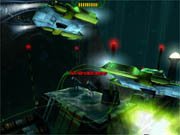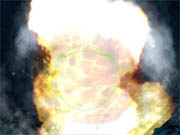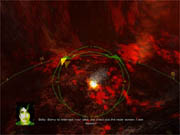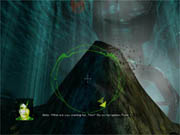If you ask gamers whether they'd generally prefer a game with beautiful graphics but shallow gameplay or one with incredibly involving gameplay but less-attractive graphics, almost all of them will immediately declare that they'd rather play the one with better gameplay. But the allure of incredible graphics is often underestimated, and many of those declarations are untrue in practice. Just as many psychology tests have demonstrated that people are more likely to undeservedly ascribe positive attributes (honesty, intelligence) to good-looking people, gamers are more likely to overlook a good-looking game's thin gameplay and design flaws. But while outstanding graphics can make a good game seem great, occasionally a game features gameplay so weak that even amazing graphics can't camouflage its flaws. Enter AquaNox, a game with far more flash than substance.

AquaNox is a belated sequel to 1997's Archimedean Dynasty, a subsim game that is similar in style to space sims like Privateer. Superficially, AquaNox features a similar design, as you'll return to the underwater world of Aqua featured in Archimedean Dynasty as a mercenary who gains credits by completing combat missions. With the money you earn from your successes, you'll be able to buy better ships and equip them with more formidable weaponry. But while Archimedean Dynasty was a complex, mission-based simulation with trading and privateering, AquaNox is an arcade-style action game that abandons or greatly simplifies those elements. Combat is fast paced and more similar in style to Quake's, or even a rail shooter's, than it is to the more tactical battles in other underwater sims.
It's disappointing that the developers opted to make gameplay so simplistic when the setting offers so many interesting possibilities. Unlike the barren environments offered by space sims, AquaNox's battles occur around subterranean buildings, gigantic peaks, and other obstructions. Yet in spite of the rich tactical promise offered by the setting, combat is so simplistic that there's little need to dodge behind obstacles or perform complex maneuvers. Instead, combats can be quickly won by just lining up opponents and blasting away while strafing in any direction. Circle strafing, which seems incredibly misplaced in a game featuring underwater vehicles (which you wouldn't expect to be able to move laterally quickly), will likely be your primary combat tactic.

There's certainly nothing inherently wrong with opting to offer arcadelike action instead of a more detailed simulation of underwater combat, but AquaNox's cumbersome controls seem poorly suited to handle the quick maneuvering necessary to keep the action interesting. While you can elect to use a joystick, the default manner for controlling your craft is an FPS-style mouse/keyboard setup. Switching to a joystick setup is a real chore, since instead of just designating "joystick" as your control device, you have to manually reprogram the controls by selecting which joystick axis or button you want to use for each function. The selections aren't always intuitive--you have to change your "direction of view" settings, instead of your "direction of movement" settings, if you want your ship to move in the direction you point--and the program refuses to accept the remapping of the "left/right" direction of view to the x-axis of a joystick, even though most games that use joysticks are set up in that manner by default. If you're uncomfortable with the way the game controls, you'll have to guess which of several "tolerance" or "sensitivity" settings you have to adjust, none of which is explained in the game's manual. It sounds confusing because it is, and if you think you've made things worse, there's no way to instantly backtrack to the game's default settings. In spite of the fact that the game is designed to be played with either a mouse or a joystick, you'll have to tediously navigate all of the game's menus with the keyboard. Setting up the controls is an incredibly awkward process.
Even once you've decided upon a control scheme that you're reasonably comfortable with, movement in the game is awkward and lacks fluidity. It's difficult to stalk enemies by lurking behind them, so combat often devolves to strafing while almost motionless or while moving almost straight forward. Even though the lack of motion should make your craft a relatively easy target, opponents rarely team up against you, which makes it possible to conveniently dispatch your enemies while remaining virtually stationary. Players who are familiar with the Descent series or who spend a lot of time practicing may be more adept at maintaining a steady aim while moving, but since you can be very effective in battle by essentially just pointing at your enemies and firing, there's little incentive to master more complex tactics.

Once you do get into the game, you'll be treated to some amazing visuals. Considering the game engine has been used for months to market Nvidia's flagship GeForce 3 video card, it's no surprise that the graphics are outstanding. The game has been designed to take advantage of all the high-end capabilities of the GeForce and its latest generation of cards, and the environments look amazing as a result. Textures are colorful and extremely detailed, and there are numerous little graphical touches, such as chips that flake off underwater hills hit by your projectile weapons. The environments are also varied and well designed, allowing you to battle around underwater volcanoes and massive structures and be aided or hindered by swift currents and other environmental effects. The explosions are primarily over-the-top fireballs, which aren't as realistic or detailed as the blasts featured in recent space sims or the subtle underwater implosion effects in Red Faction, but they seem appropriate in an arcadelike action game like AquaNox. AquaNox's graphics were much vaunted in advance of the game's release, and they definitely live up to the high expectations that hype generated. AquaNox's graphics represent the state of the art for computer games.
The premise behind the plot is that civilization has been driven underwater, and the remnants of humanity are divided into various factions competing for dominance while battling the hazards endemic to their adopted underwater homes. The plot is simplistic and advances in a linear fashion by completing assigned missions. Between missions, you can purchase new equipment and speak with nonplayer characters to get information needed to initiate the next mission. The dialogue is terrible, even for a game of this type, and the voice acting of almost all the characters (other than the protagonist) is grating. Some of the NPCs have astonishingly bad, childlike voices and almost equally exaggerated facial caricatures. Woody Woodpecker at 20,000 leagues.

You can't save the game during missions, but almost all the missions are very brief, and many of them can be completed in just a couple of minutes. Mission goals are varied, and often you'll have the assistance of allied fighters. Friendly forces act independently, so you won't be able to assign them to specific targets or goals. The lack of wingman commands is another example of the decision that the designers made to deemphasize elements you'd typically see in a simulation to make the game more arcadelike. The heads-up display of your craft includes nonfunctional switches and is also very simple. There's a targeting system that displays rudimentary information on your current opponent, but there's no way to cycle through available enemies or target anything without pointing and clicking on it through your targeting reticule. The only polished element of the interface is the sonar display, which provides a very detailed overview of your surrounding area.
The game's music consists primarily of pseudo-techno jingles that are more distracting than anything else. Sound effects are appropriately loud to match the onscreen action, and a variety of environmental sound effects are supported, including Creative Lab's dominant EAX2 standard, but effects never seem isolated to specific locations. There's nothing subtle about AquaNox.
In addition to the single-player campaign, there are a few instant-action settings and multiplayer dogfight scenarios, but they're unlikely to significantly extend the longevity of AquaNox. The designers have chosen to abandon or pare down simulation and role-playing elements to deliver a more accessible, faster-paced action game, but the action just isn't very interesting, especially by itself. While the graphics are undeniably great, the battles are dull, and the awkward controls and extremely brief missions prevent AquaNox from being engrossing as an action game.